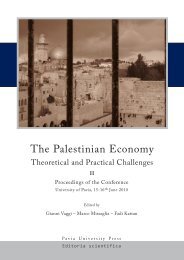Musica che affronta il silenzio - Scritti su Toru Takemitsu - Pavia ...
Musica che affronta il silenzio - Scritti su Toru Takemitsu - Pavia ...
Musica che affronta il silenzio - Scritti su Toru Takemitsu - Pavia ...
You also want an ePaper? Increase the reach of your titles
YUMPU automatically turns print PDFs into web optimized ePapers that Google loves.
Music Facing Up to S<strong>il</strong>ence. Writings on Tru Takemit<strong>su</strong><br />
quite clearly, and provides various stimuli for analysis and <strong>su</strong>bsequent reflections. I shall<br />
now present a brief analysis of Kwaidan by way of example. 31<br />
A grand fresco of feudal Japan<br />
Kwaidan (1964), presenting a sweeping portrait of feudal Japan, is perhaps Masaki<br />
Kobayashi’s most famous f<strong>il</strong>m, winner of the Special Jury Prize at the 1965 Cannes Festival.<br />
32 During the 1950s Kobayashi made a name for himself with a number of f<strong>il</strong>ms<br />
with a precise point to make, many of them taking an intransigently anti-war stance. So<br />
one can perhaps characterise Kobayashi as making ‘m<strong>il</strong>itant cinema’, although his approach<br />
seemed to avoid ideological implications. 33 In The Thick-walled Room (Kabe<br />
at<strong>su</strong>ki heya, 1956), with a script by the writer Kb Abe based on the diaries of soldiers<br />
imprisoned following the War accused of committing war crimes, the director’s position<br />
can be described as one of ‘moral solicitation, an invitation to engage in a more searching<br />
reflection on all the wrong that had been done’ (Novielli 2001: 148). After an investigation<br />
of the world of sport and the corruption at work within it (I’ll Buy You, Anata<br />
kaima<strong>su</strong>, 1956), Kobayashi turned his attention to the situation of the American bases<br />
(Black River, Kuroi kawa, 1957) and then went on to f<strong>il</strong>m the monumental The Human<br />
Condition I (Ningen no jken, 1959-1961), lasting nearly ten hours. The 1960s saw the<br />
famous triptych which secured its author a number of prestigious prizes: Kwaidan, Seppuku,<br />
Special Prize at Cannes, in which Kokayashi criticised the bushid and the ideals of<br />
the samurai in the collective imagination in Japan, 34 and Samurai Rebellion (Ji-uchi,<br />
1967), Critics’ Prize at Venice, a further attack on the mores of the past in the story of the<br />
revenge wreaked by a samurai for a slight on his honour.<br />
Drawing on the writings of Yakomo Koizumi (alias Lafcadio Hearn), Kwaidan deals<br />
with some of the typical motifs of Japanese culture in four episodes characterised by the inco-<br />
31<br />
Takemit<strong>su</strong> himself referred to Kwaidan and Susa no onna as the two peaks of his experimentation in sound.<br />
Cf. Tessier (1985: 100).<br />
32<br />
‘Basically, a Japanese f<strong>il</strong>m practically has no chance of existing in the West unless it has been screened at<br />
an important f<strong>il</strong>m festival, or, better st<strong>il</strong>l, awarded a prize. [...] Thanks to the Venice F<strong>il</strong>m Festival, Kurosawa<br />
and Mizoguchi, then Kobayashi (Ningen no joken) were discovered; at that point further recognition was<br />
obtained at [the] Cannes [F<strong>il</strong>m Festival] (Harakiri; Kwaidan)’ (Tessier 2008: 70-71).<br />
33<br />
‘All my f<strong>il</strong>ms, from a certain time on, are about power, about struggling against authority. That became my<br />
main theme. That’s what The Human Condition is about and Harakiri of course… and Samurai Rebellion as<br />
well. I was opposed to the abuse of power. This was true of my own life in the m<strong>il</strong>itary. I resisted m<strong>il</strong>itarism<br />
and that whole system of m<strong>il</strong>itary power. But everything then was so rigidly controlled. We didn’t dare speak<br />
out. It was only after the war that we could openly address this’ (Masaki Kobayashi in Zwerin, 1994).<br />
34<br />
‘Composition, camera movement, action and sound all combine to make a f<strong>il</strong>m equivalent of the highest<br />
form of martial art. The way in which the combatants face off against each other, hardly moving for long<br />
moments, is a near-perfect expression of the concept that a fight is won before the sword has left the scabbard<br />
– physical action is <strong>su</strong>perseded by mental conflict’ (Tucker 1973: 100).<br />
187

















